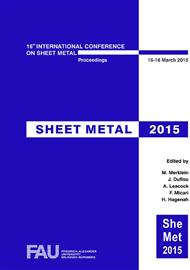p.267
p.275
p.283
p.291
p.301
p.309
p.317
p.325
p.333
Formability Characteristics of Hot Stamped Ti6Al4V Sheets Electro-Chemically Modified on Surface for Biomedical Applications
Abstract:
Over these last decades Ti6Al4V has been largely employed for biomedical applications because of its biocompatibility and high strength-to-weight ratio. According to several studies, the implantation success is strongly dependent on the characteristics of its surface, since the roughness and the chemical composition of the surface play an important role in the osseointegration of the implant and in its bioactivity, respectively.In this paper different thermo-electro-chemical treatments were applied to Ti6Al4V sheets to increase their roughness for biomedical applications. The Ti6Al4V sheets underwent three different treatments, namely acid etching, acid etching followed by anodization and etching in a hydrothermal reactor, and finally furnace annealing.After the etching and annealing treatments, the surface morphology of the samples were analysed through Scanning Electron Microscopy, while its chemical composition was identified through the Energy Dispersive Spectroscopy. The surface roughness and topography were evaluated by using a 3D profilometer. Furthermore, the bioactivity of the treated samples was evaluated by diving them in Simulated Body Fluid and then analysed through SEM and EDS analyses.Based on these results, the treatment assuring the best performance in terms of roughness and bioactivity was identified and then applied to tensile samples tested at 700°C and strain rates of 0.1 and 1s-1 to evaluate the impact of the surface treatment on the material formability and, therefore, to prove the feasibility of applying the hot stamping process to surface modified sheets.
Info:
Periodical:
Pages:
301-308
Citation:
Online since:
March 2015
Authors:
Keywords:
Price:
Сopyright:
© 2015 Trans Tech Publications Ltd. All Rights Reserved
Share:
Citation:


